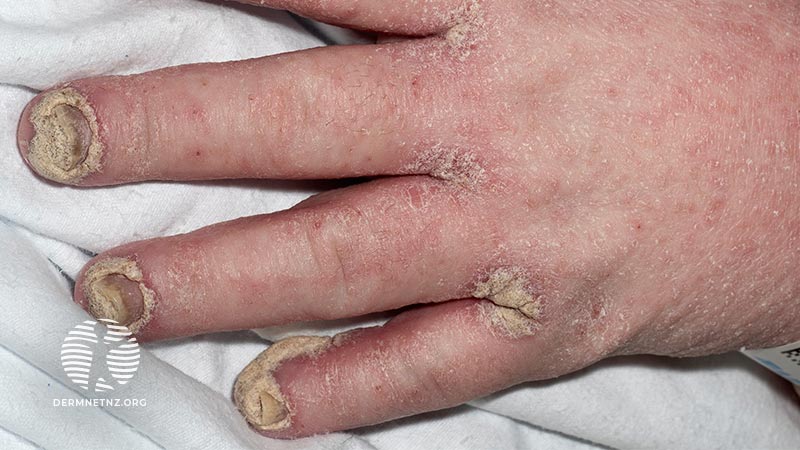Main menu
Common skin conditions

NEWS
Join DermNet PRO
Read more
Quick links
Widespread itchy rash in a patient with Trisomy 21
Last reviewed: October 2023
Author: Dr Stanley Leong, Dermatology and Paediatric Registrar (2023)
Reviewing dermatologist: Dr Ian Coulson (2023)
Edited by the DermNet content department

Background
A 34-year-old woman with trisomy 21 presented with a rapidly worsening rash of 4 months. The rash was associated with marked scratching that started on her hands then spread throughout the body. She had no preceding skin disorders.
Other family members had a recent history of itch that improved with time but hers deteriorated.
On examination, she appeared miserable with thick, crusty plaques over her forehead, nails, fingers, wrists, toes, and soles with multiple linear fissures.
Dermoscopic examination showed many live mites and burrows.
What is the likely diagnosis?
Crusted scabies is a highly contagious hyperinfestation with Sarcoptes scabiei var hominis a parasitic mites, presenting in immunocompromised patients. It is previously known as Norwegian scabies.
It is estimated that individuals with crusted scabies have up to 4,000 mites/g of skin. Patients are often infested with over 1 million mites. The majority of patients with normal scabies are infested with only with around 10–20 mites.
Scabies is readily diagnosed clinically and confirmed by identification of mites or eggs on dermoscopic or microscopic examination of burrows or scale in crusted disease.
What is the treatment?
Treatment requires oral ivermectin and topical insecticides:
- Oral ivermectin (200 mcg/kg/dose) given on days 1, 2, 8, 9, and 15 (add days 22 and 29 if infestation is severe)
- PLUS topical 5% permethrin or topical 5% benzoyl benzoate applied daily for seven days, then twice weekly until cure.
Family members, carers, and close contacts should also be screened for scabies and treated accordingly. Regardless of examination findings, all family members who have had close contact with the index case should be treated with a topical scabicide and should repeat treatment in one week.
What are the risk factors for this condition?
Risk factors for crusted scabies include:
- Primary or acquired immunodeficiency
- Down syndrome
- Dementia — neglected care
- Human immunodeficiency virus infection (HIV)
- Lymphoma
- Systemic lupus erythematosus (SLE)
- Long-term corticosteroid or immunosuppressant use
- Institutional accommodation — prisons and nursing homes (institutional scabies).
